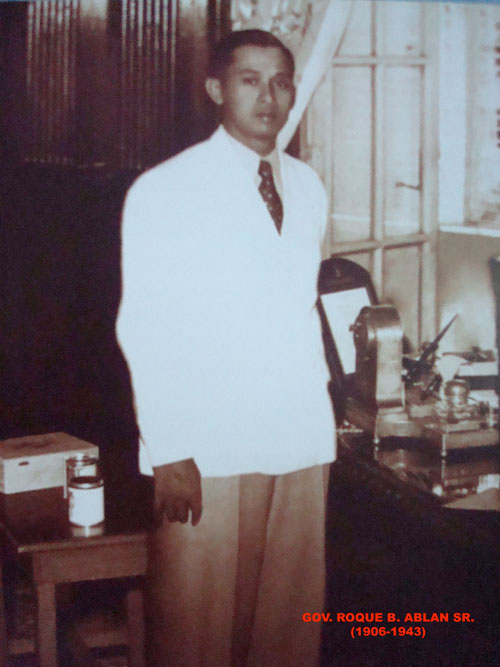|
Governor Roque B. Ablan, an outstanding public servant and World War II hero
 Philippine history is replete with stories of heroes struggle to win independence. During World War II, there were government officials who refused to extend cooperation with the Japanese and, instead, with the support and cooperation of patriotic civilian population, organized guerrilla units. One of them was Ilocos Norte Governor Roque B. Ablan. Philippine history is replete with stories of heroes struggle to win independence. During World War II, there were government officials who refused to extend cooperation with the Japanese and, instead, with the support and cooperation of patriotic civilian population, organized guerrilla units. One of them was Ilocos Norte Governor Roque B. Ablan.
Roque Ablan was born in Laoag, Ilocos Norte on August 9, 1906, an industrious and diligent child, he worked as a helper in a lumberyard in Laoag for extra money to defray his school expenses at the Laoag Elementary School and then at the Ilocos Norte Provincial High School.
He went to the University of the Philippines and, as a working student, obtained a Bachelor of Philosophy degree in 1929 and a Bachelor of Laws degree in 1930.
On June 27, 1931, Roque married Manuela Ravelo, a teacher from Batac. A year later, on 22 April, she gave birth to their only child.
In 1937 at age 31 he was elected governor of Ilocos Norte making him the youngest provincial executive of his time. Among his outstanding achievements as governor was the establishment of the Ilocos Norte provincial hospital, establishing of the Philippine Normal School in Laoag, which gave quality education to countless Ilocano youth at low cost, thus, giving the public equal opportunity to obtain education. For his keen concern for the welfare of his people, especially the poor, he earned the admiration and respect of his constituents thus he was re-elected to a second term in 1941.
On 10 December 1941, two days after the bombing of Pearl Harbor in Hawaii, Japanese troops had already landed in Vigan. Shortly, part of this force moved towards Laoag. Ablan refused to extend his cooperation to them. To avoid arrest, he left the provincial capitol in Laoag and transferred the seat of government to a remote barrio near the boundary of Ilocos Norte and Apayao. From there he contacted and enlisted the support of government officials, prominent citizens, and trainees and decided to organize a guerrilla unit while the enemies were invading the province. In mid-January 1942 in Nueva Era, he met with Lt. Feliciano Madamba, an officer of USAFFE (United States Armed Forces in the Far East), and the two agreed to organize the Ablan-Madamba Guerrilla Group of Northern Luzon.
The first encounter of the Ablan-Madamba guerrillas had with the Japanese happened on January 27, 1942 in Solsona, when they successfully ambushed a Japanese detachment, killing about 60 Japanese soldiers in the process.
Ablan needed to send some reports to President Quezon who was then in Washington D.C. In March 1942, he hiked through the mountains for 5 days to get in touch with Capt. Ralph Praeger who was manning the radio transmitter in Apayao. On March 10 he was able communicate with Commonwealth authorities to whom he reported that despite the occupation of Laoag and San Nicolas, Ilocos Norte, government is still functioning and the people have not alienated a bit of their allegiance to leadership and to the Philippine Government, and to the United States Government.
Ablan transferred all the available weapons at Camp Juan to the barrios of Kabusan and Nalasin, Solsona. He divided the province into several sectors, each of which was placed under a guerrilla leader. He assigned Lt. Isabelo Monje to take charge of operations in Batac, Paoay and Currimao; Vicente Cajigal was assigned the towns of Badoc, Pinili and Nueva Era. The governor also named Juan Albano as deputy governor; Lt. Madamba as executive officer, and Primo Lazaro and Damaso Samonte as chiefs of the intelligence corps. Capt. Pedro Alviar was placed in charge of the counter intelligence unit. The intelligence section was established to gather information from all possible sources. A runner-relay system was also set up to disseminate news and send orders to different sectors, thus linking towns and scattered guerrilla camps.
Ablan’s guerrillas had a series of bitter skirmishes with the Japanese. After Bataan and Corregidor had fallen, the Japanese under Col. Watanabe established their headquarters in Laoag. Ground forces hunted Ablan and his resistance fighters and air units dropped leaflets urging Ablan and his men to surrender. He refused to give up the struggle. A series of raids were staged on his guerrilla camp. He escaped enemy traps but his outfit nevertheless sustained tremendous losses. His units then adopted hit-and-run tactics. The enemy tried to persuade him with promises provided he stop his resistance activities.
On November 8th, 1942, Ablan struck again and had an encounter with the Japanese at Pampanniki, Solsona, causing about 200 Japanese casualties.
The last time his family saw him was on December 10th, 1942, when he left for Cagayan to confer with Governor Marcelo Adduru. But he never came back.
He was last seen at the battle of Bumitalag, Piddig on February 5th, 1943. The Ablan-Madamba group was recognized by General Douglas MacArthur’s Southwest Pacific Area Command which sent the submarine USS Stingray to contact Ablan and deliver arms and supplies for his resistance movement in August 1944. But was nowhere to be found.
Back to History Index
 |
Philippines |
2006 |
Roque B. Ablan birth centenary (1906-2006), World War II hero |
 |
Philippines |
2006 |
Roque B. Ablan birth centenary (1906-2006), World War II hero (sheetlet of 8 stamps) |
|